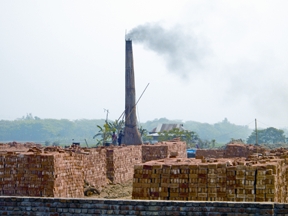Brickfield
Brickfield a manufacturing unit to manufacture bricks from mudsoil or clay. Dependence on mud bricks as construction material in Bangladesh is common since the country is covered with alluvial soil and stone materials are being scarce. That bricks had been used for construction since ancient time is borne by the fact that structures in the fourth century BC township of pundravardhana at mahasthan were built with bricks.

There are about 6,000 brick manufacturers in Bangladesh. Many of them do not have proper license and local government authorities do not have necessary resources and support to police the regulations or to keep track of the fields.
Brick production in the country is estimated at about 18 billion pieces a year. The brickfields are typically small independent units. Most operate only during the dry season. The fields are located near towns or major construction sites. The same locations are used repeatedly over years. Some has permanent shed and well-organised input support system.
Such fields with relatively large investment and modern equipment including automated plant produce better quality bricks. The clay used for brick production is usually mined near the brickfields. But at times suitable clay is transported from distant locations.
Except in automated plants, brick blocks are molded manually and piled close to the firing ovens so that they can be dried. Drying takes 5 to 12 days, after which the blocks are put into kilns for firing. Blocks in kilns are covered with brick dust for insulation. In fields, which are not automated and do not have gas connections, the firing starts with wood and later continues with coal. The coal is imported mainly from India because it is cheaper. Substitutes of coal in some cases include wood dust, furnace oil and even rejected tyres. natural gas is used in only about 200 brickfields that are close to gas distribution networks around dhaka, brahmanbaria and chittagong.
Using firewood in brickfields is banned legally, but actually the practice still continues on a fairly large scale. Brickfields classify construction bricks into three grades depending upon quality of raw materials used, evenness of firing and damages like cracks or breaks. Grade I is suitable for construction of buildings, roads and bridges, grade II for structures requiring relatively less compressive strength, and grade III for temporary structures. Automated brickfields produce mainly grade I bricks and also ceramic and refractory bricks used in construction of decorated buildings, boilers and some specialised industrial establishments. Brickfields have been blamed for increasing air pollution, especially during the dry season. The pollution is caused by poor quality of fuel and improper design of chimneys. Ash, dust and sulfur dioxide gas pollute the areas surrounding brickfields and acid rain syndrome has become a regular phenomenon in such areas. Brickfields also cause crop loss, corrosion of metallic content of soil and loss of soil fertility. Burning in kiln makes the land unusable for cultivation for several years. [Mushfiqur Rahman]
